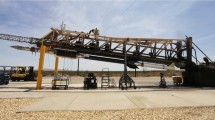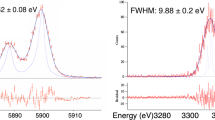Abstract
Micro-X is an X-ray sounding rocket payload that had its first flight on July 22, 2018. The goals of the first flight were to operate a transition edge sensor X-ray microcalorimeter array in space and take a high-resolution spectrum of the Cassiopeia A supernova remnant. The first flight was considered a partial success. The array and its time-division multiplexing readout system were successfully operated in space, but due to a failure in the attitude control system, no time on-target was acquired. A re-flight has been scheduled for summer 2022. Since the first flight, modifications have been made to the detector systems to improve noise and reduce the susceptibility to magnetic fields. The three-stage SQUID circuit, NIST MUX06a, has been replaced by a two-stage SQUID circuit, NIST MUX18b. The initial laboratory results for the new detector system will be presented in this paper.



Similar content being viewed by others
References
G.M. Stiehl et al., IEEE Transactions on Applied Superconductivity 21, 3 (2011). https://doi.org/10.1109/TASC.2010.2091483
C.D. Reintsema et al., IEEE Transactions on Applied Superconductivity 29, 5 (2019). https://doi.org/10.1109/TASC.2019.2904594
S. N. T. Heine. High-Resolution Studies of Charge Exchange in Supernova Remnants with Magellan, XMM-Newton, and Micro-X. PhD thesis, Massachusetts Institute of Technology (2014).
NASA Sounding Rockets User Handbook Sounding Rockets Program Office Sub-orbital and Special Orbital Projects Directorate. (n.d.).18, (2022), from https://sites.wff.nasa.gov/code810/files/SRHB.pdf
J. S. Adams et al., J. Low Temp. Phys., This Special Issue (2021)
XCal GSE v11.1.6 [software], NASA/GSFC (2019)
Acknowledgements
The Micro-X project is conducted under NASA grant 80NSSC20K0430. Part of this work was performed under the auspices of the U.S. Department of Energy by Lawrence Livermore National Laboratory under Contract DE-AC52-07NA27344. R. Manzagol-Harwood acknowledges financial support from the IDEAS Fellowship, a research traineeship program funded by the National Science Foundation under grant DGE-1450006 and from the Illinois Space Grant Consortium Graduate Fellowship Program.
Author information
Authors and Affiliations
Corresponding author
Additional information
Publisher's Note
Springer Nature remains neutral with regard to jurisdictional claims in published maps and institutional affiliations.
Rights and permissions
About this article
Cite this article
Adams, J.S., Bandler, S.R., Bastidon, N. et al. Micro-X Sounding Rocket Payload Re-flight Progress. J Low Temp Phys 209, 832–838 (2022). https://doi.org/10.1007/s10909-022-02771-3
Received:
Accepted:
Published:
Issue Date:
DOI: https://doi.org/10.1007/s10909-022-02771-3




